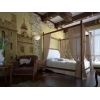|
 You've come
to the idea to decorate your interior in Gothic style. This is good idea, the Gothic
style is one of the recognizable and expressive artistic styles with some stateliness
and solemnity and the dignity where everyone finds something to the taste.
Someone will like the lancet arches, the other will prefer magnificent stained-glass
window, third will appreciate Gothic-styled trunks or chair, and there are
people who will risk to have in the interior the carved locker. You've come
to the idea to decorate your interior in Gothic style. This is good idea, the Gothic
style is one of the recognizable and expressive artistic styles with some stateliness
and solemnity and the dignity where everyone finds something to the taste.
Someone will like the lancet arches, the other will prefer magnificent stained-glass
window, third will appreciate Gothic-styled trunks or chair, and there are
people who will risk to have in the interior the carved locker.
 The European Gothic
style as the esthetic tradition in architecture and design appeared as the
alternative to the Roman style with heavy and fundamental, and pragmatic
details. Abbeys, churches, and town halls built and decorated in Gothic style
have more delicate outlines, equipped with sculptures, arches, semiarchs and flying
buttress, decorative carving, stained-glass window and others.
The European Gothic
style as the esthetic tradition in architecture and design appeared as the
alternative to the Roman style with heavy and fundamental, and pragmatic
details. Abbeys, churches, and town halls built and decorated in Gothic style
have more delicate outlines, equipped with sculptures, arches, semiarchs and flying
buttress, decorative carving, stained-glass window and others.
Buildings constructed
in Gothic style look erected to the heavens because of the newly invented
framing in construction, with high windows, broaches on the top of roofs, and
inside the premises the interior is decorated with wood painting or frescos, wall
papers and thin Flemish carpets. Respectively, the Gothic furniture is simple,
delicate, and emaciated though it follows all artistic rules presenting ogives,
ornamental patterns, leaf, shield or roses carved on wood.
There is another
embellishment that faultlessly shows the Gothic-styled furniture is the carving
as folds and drapes or a roll of leather with rounded edges. Moreover, the
Gothic style carvers widely practiced works with carved arms, various garlands
and rolls.
The
revolution in the sphere of furniture was significant to the same extent as the
confrontation of the Gothic style to the Romantic in architecture. In addition,
the interior items were mainly made replicating architecture elements applied
to towers and temples in wooden pieces, like a rounded chair hack, stretched up
as the dome, trough-carved work imitating arches and high windows and legs as
columns.
All in all,
all the furniture we use now would be impossible without a Gothic style since
this style caused production of chairs and tables on the frames and to the
lighter and delicate items abundantly decorated by painters and gilders.
The Gothic
furniture from the North and West of Europe was manufactured from oak or nut, and
the furniture from the South and the East was made from spruce, pine and cedar.
There are items we still use as desks with a lot of drawers, sliding tables,
though there are still pieces of furniture that lost all their meaning for us,
like cabinets to store Christmas gifts, dressier and other cupboards to store
kitchen utensils of various types.
As for the geographic
factor, it is hard to single out something since the superb Gothic furniture, beds,
trunks and cupboards for washing belongings were manufactured in Tyrol, while
wonderful Gothic items like desks and library cupboards were made in Hungary.
The Italian
Gothic furniture is less expressive, since classicism that originates from the
antique times was the priority artistic tradition for ever times, though Lombard and Tuscan curved trunks were very interesting
and expressive. There are more items made in Florence or Sienna that attract attention of
collectors.
The surface
finish of Gothic furniture in Italy
is far more varied, all the more the geometric and floral ornaments is
complimented with décor in Mauritanian style.
The Gothic shapes
in furniture and architecture are extremely expressive, various and decorative,
and however they reigned not for ever. When the world got full of them, it enjoyed
the classic antique traditions that are beyond the time and the vivid
Gothic-styled items can serve as effective accents. Bear in mind that you can abuse
of Gothic items that will not look stylish and harmonic.
|